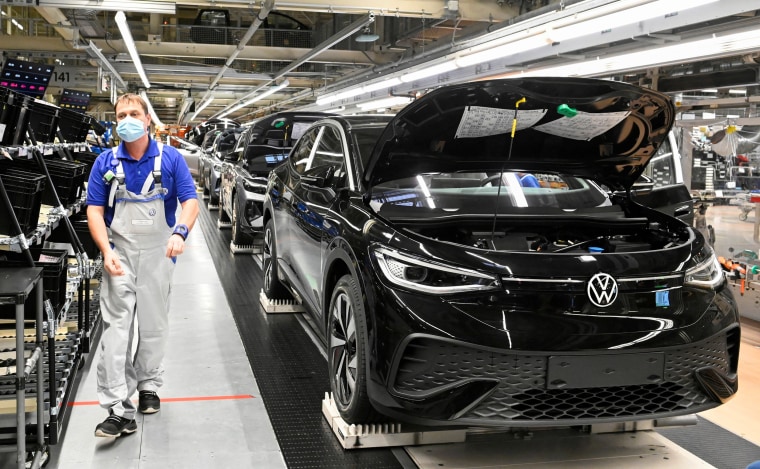In the battle to dominate the emerging market for battery-electric vehicles, two industry giants are trading shots in each other’s home market.
This week saw Tesla officially launch production at its new "Gigafactory" in Berlin. The plant is located just an hour away from the Wolfsburg headquarters of Volkswagen AG, Europe’s largest automobile manufacturer and the current leader in European electric vehicle sales.
But the German automaker is taking the fight to the U.S., a market where Tesla is the overwhelmingly dominant EV manufacturer. VW announced plans this week to invest $7.1 billion in North America, where it will add new production capacity for all-electric models like the ID.Buzz microbus.
VW and Tesla have done little to hide their goals of dominating the expanding market for battery-electric vehicles. In a tweet marking the roll-off of the first production vehicles at the Berlin factory, Tesla CEO Elon Musk said the goal of his company’s “master plan part 3 … will be scaling to extreme size.”
Tesla already has four assembly plants in place, including its original one in Fremont, California, and another in Shanghai that began producing vehicles in 2019. The new Berlin plant and a fourth in Texas will roughly double its production capacity. Musk has frequently said he envisions adding a number of other plants in the coming years.
For its part, Volkswagen has committed more money to going electric than any other car company, upping the figure to more than $100 billion by 2030. That will fund the shift away from internal combustion engines — which are powered by old-fashioned gasoline — for 14 different brands. That includes the entry-level Seat and Skoda to exotic marques such as Porsche and Lamborghini. Its Audi and Bentley brands have already laid out plans to be 100 percent electric by the end of this decade, with others, including the flagship Volkswagen marque, set to follow soon afterward.
VW already has a growing array of electric vehicle production facilities operating in Europe and China. It has been slow to grow its manufacturing footprint in the American market, starting to import the German-made ID.4 in late 2020. It is just finishing the expansion of an assembly plant in Chattanooga, Tennessee, that will produce the ID.4, but its aspirations don’t stop there.
“This profound commitment to our localized capabilities will transform Volkswagen into one of the leading EV brands known for its commitment to innovation, quality, and the communities we call home,” Scott Keogh, president and CEO, Volkswagen Group of America Inc., said in a statement this week.
Officials at both Tesla and Volkswagen have made clear their intent to topple each other in their respective home markets. Tesla is the overwhelmingly dominant player in the U.S., producing two of the four best-selling battery-electric vehicles in the market. But Volkswagen expects that 55 percent of its sales in the U.S. will consist of all-electric vehicles by 2030.
In Europe, VW holds a 25 percent share of EV sales, according to data from the European Automobile Manufacturers' Association — compared to 13 percent for Tesla, Brinley said. But the Berlin factory gives the company the production capacity to fuel a significant growth surge.
IHS Markit analyst Stephanie Brinley downplays the idea that this is a battle of the electric titans, however.
“There’s only upside for both of them,” she contends, as they expand their presence in North America, Europe, China and other markets. EVs account for only a small fraction of global demand — just 3 percent in the U.S., though some markets, such as Norway and Britain, have climbed solidly into the double digits.
“The EV market is on the upswing, so there’s only going to be growth opportunities” ahead, she added.
Of course, Tesla and VW are by no means the only automakers hoping to capitalize on the shifting market. GM plans to launch at least 30 all-electric vehicles worldwide by 2025, including the new Cadillac Lyriq it started building this week. GM intends to go 100 percent EV by 2035. Volvo plans to reach that target before the end of this decade. And major players such as Ford, Honda, Toyota and the Hyundai Motor Group are all moving in similar directions.
For the near-term, at least, EV demand could exceed production capacity, according to Brinley and other automobile analysts.
